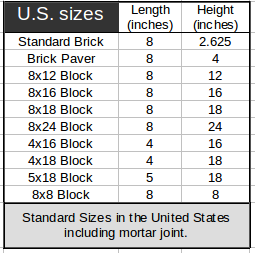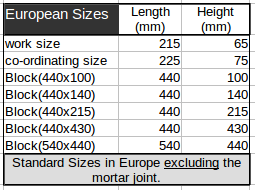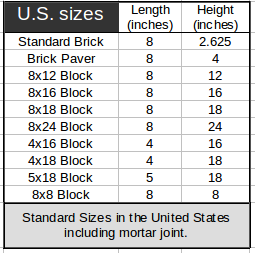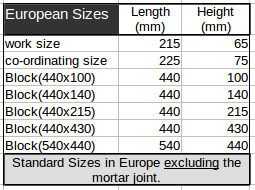The Custom Stone in a Wall calculator computes the number of bricks, blocks or uniformly cut stone needed for a wall based on the dimensions of the wall, the length and height (face) of the stone, brick or block and the thickness of the mortar joints.
INSTRUCTIONS: Choose units and the following:
- (L) Wall Length
- (H) Wall Height
- (SH) Stone Height
- (SL) Stone Length
- (mj) Mortar Joint thickness. In the U.S., it's often 3/8" and 10mm in Europe.
Number of Stone (nS): The calculator returns the number of masonry units (e.g., cut stone) needed for the wall. It also returns:
- (nS) Number of Cut (Total)
- (nR) Number of Rows to achieve wall height
- (nSPR) Number of Stones per Row to achieve wall length
- (TR) Height or Thickness of Top Row to get exact height (H) of wall with standard row heights below.
- (A) Wall Face Area
The Math / Science
The Variable Sized (brick, block or stone) equation calculates the number of brick, block or cut stone needed for a wall based on the dimensions of the wall and the size of the brick, cut stone or block. This calculation is for a wall or fascia wall which implies that wall is one unit (brick, block or stone) deep. The user identifies the height and length of the wall and enters the dimensions of the masonry unit. vCalc will then calculate the number of units needed for the wall. The graphic shows a straight wall. However, the length can be provided for a circular or other-wised curved or serpentine wall, and the calculation should be accurate.
To do this, vCalc calculates the area of a wall and then uses the dimensions of brick, block or stone to determine how many units are needed for the construction of the wall. This is an ESTIMATION, and actual number of units needed may vary based on the thickness of the mortar joints and other factors. Nonetheless, this formula does take into account a nominal mortar joint.
Brick, block and cut stone walls are used in many applications, ancient to modern. They can be found in homes, building, and gardens. They can also be seen in general landscaping as retention walls.
Masonry Calc (Concrete, Brick and Block, Rebar)
The MASONRY suite includes collections of functions associated with product estimations on projects done with brick, block, concrete and rebar.
Concrete Slab Calculators
The following functions apply to estimating the amount of concrete, rebar, form boards and water needed for concrete slabs of different shapes: rectangular with squared corners, circular including semi-circle, and polygon shapes from triangular up (e.g., pentagon for 5 sides and dodecagon for 12 sided polygon).
Rectangle Slab
- Rebar and Concrete in a Slab: Computes the total length and weight of rebar and the volume and weight of concrete needed for a rectangular slab, taking into account the concrete displaced by the rebar.
- Concrete in Rectangle Slab: Computes the volume of concrete in a rectangle (squared corners) slab based on the dimensions. It includes the volume of concrete in cubic yards and the equivalent volume in bags of concrete. It also includes the surface area, length of form boards, and the water requirement.
- Slab Weight: Computes the weight, volume of concrete and surface area of a rectangle slab based on the length, width and depth of the concrete of the slab and the density of concrete.
- Weight of Slab with Rebar: Computes the weight of a rectangle slab with rebar based on the length, width and depth of the concrete of the slab, the density of concrete and the size and spacing of rebar. It includes total weight (concrete and rebar), and the contribution of weight from rebar and concrete separately.
- Slab Area and Perimeter: Compute the surface area and perimeter of a rectangular slab based on the dimensions.
Circular Slab
- Volume of Circular Slab: Computes the slab surface area, perimeter and cubic yards of concrete in a circular slab based on the diameter and depth. It also provides, the equivalent volume in 80lb, 60lb and 40lb bags of concrete and the water requirement.
- Circular Slab Weight: This computes the weight of the concrete in a circular slab based on the diameter, depth and density of concrete.
- Rebar and Concrete in a Circular Slab: This computes the length and weight of rebar in a rectangular slab. It also computes the total weight of the slab including concrete, taking into account the concrete displaced by rebar.
- Semi-Circle Slab Volume: Computes the volume of concrete needed for a semi-circular slab based on the radius and depth.
- Semi-Circle Slab Weight: Computes the weight of concrete in a semi-circular slab based on the radius, depth and density of concrete.
Polygon Slab
- Concrete in Polygon Slab: Computes the surface area and cubic yards of concrete for a polygon slab based on the dimensions and depth. It also provides the equivalent volume of concrete in 80lb, 60lb and 40lb bags of concrete.
General Functions
- Concrete Weight: Computes the weight of a specified volume (e.g., 2.3 cubic yards) of concrete.
- Price of Delivered Concrete: Computes the price of delivered concrete based on the volume, price per cubic yard, pumping cost, delivery distance, and mileage.
- Water Needed for Concrete: Compute the amount of water needed to make a volume of concrete.
- Concrete Displaced by Rebar: Computes the volume of concrete displaced by a length of rebar based on the length and size of rebar.
Masonry Walls (Brick, Block, Mortar Joints)
- Brick or Block Wall: Computes the number of brick or block needed for a wall based on dimensions.
- Bricks or Blocks in a Wall
 : Computes the number of standard U.S. brick or block needed for a wall using feet and inches.
: Computes the number of standard U.S. brick or block needed for a wall using feet and inches. - European Brick or Block in a Wall
 : Computes the number of standard European bricks or block in a wall using meters and centimeters.
: Computes the number of standard European bricks or block in a wall using meters and centimeters. - Custom Stone in a Wall: Computes the number of masonry units (stone, block or stone) in a wall based on the dimensions of the wall and the dimensions of the units and the thickness of the mortar joints. It also returns the number of rows needed and the number of stone per row.
- Concrete, Rebar and Forms for Wall: Computes the volume of concrete, amount of rebar and the surface area of forms for a concrete wall.
Foundations - Footers - Piers
- Blocks in a Foundation: Computes the number of blocks needed for a foundation based on the dimensions of the foundation and the size of the blocks with a standard size mortar joint.
- Concrete in a Poured Foundation
: Compute the volume of concrete, the square feet of the forms and the number of 4'x8's needed for the forms.
- Concrete in a Footer: Computes the volume of concrete for a footer based on the length, width and depth of the footer.
- Concrete in a Footer (Cross Section): Computes the volume of concrete for a footer based on the length and cross-section area of a footer
- Concrete in a Pier: Computes the volume of concrete in a circular pier based on the radius and depth of the pier.
- Piers for a Building: Computes the number of piers and volume of concrete need for the piers of a building (e.g., pole barn) base on the building dimensions, pier spacing, diameter and depth.
- Concrete around Circular Post: Computes the volume of concrete around a number of round posts in a round hole based on the size of the hole and dimensions of the post.
- Concrete around Square Post:
Computes the volume of concrete around a number of square post (e.g., 6x6) in round hole based on the dimensions of the post, depth and width of the round hole.
Masonry Wall Calculators (Brick, Block, Mortar Joints)
Bricks or Blocks for a Wall: Computes the number of bricks or blocks needed for a wall based on the wall's dimensions and the size of the bricks or block.
- Brick Block Wall Cost: Computes the number of brick or block needed for a wall based on the wall dimensions and the brick or block size, and then applies a cost per unit to the number to estimate the total cost of bricks or blocks.
- Mortar Requirement for Wall: Computes the amount of mortar for a wall based on the dimensions of the wall and the size of the brick or block used.
- Bricks for a House: Estimates the number of bricks needed for a four walled structure (e.g., house) based on the building dimensions, the size of the bricks or blocks and the square footage dedicated to doors and windows.
- Cost of Bricks for a House: Estimates the number of bricks for a four walled structure and applies a unit price per brick or block to estimate the total cost.
- Block for a Foundation: Computes the number of blocks needed for the walls of a foundation based on the dimensions of the foundation and the size of the blocks.
- Cost of Blocks for a Foundation: Estimates the number of block for the wall of a foundation based on the dimensions of the foundation and the size of the blocks, and then applies the unit price per block to provide cost estimate.
- Mortar Needed for Foundation: Estimates the amount of mortar needed for the cinder block walls of a foundation based on the dimensions of the walls, size of blocks, and thickness of the mortar joint.
- Bricks per Row:
 Computes the number of bricks in a row based on the length of the row, the size of the bricks and the width of the mortar joint.
Computes the number of bricks in a row based on the length of the row, the size of the bricks and the width of the mortar joint. - Bricks High: Computes the number of rows of bricks to achieve a height based on the height and the size of the bricks.
- Custom Stone in a Wall: Computes the number of masonry units (stone, block or stone) in a wall based on the dimensions of the wall and the dimensions of the units and the thickness of the mortar joints. It also returns the number of rows needed and the number of stone per row.
- Concrete, Rebar and Forms for Wall:
 Computes the volume of concrete, amount of rebar and the surface area of forms for a concrete wall.
Computes the volume of concrete, amount of rebar and the surface area of forms for a concrete wall. - Price of Delivered Concrete: Computes the price of delivered concrete based on the volume, price per cubic yard, pumping cost, delivery distance, and mileage.
- Water Needed for Concrete: Compute the amount of water needed to make a volume of concrete.
- Concrete Mix: Computes volume and weight of cement, sand, gravel and water requires to make a volume of concrete.
